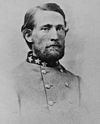This article has multiple issues. Please help improve it or discuss these issues on the talk page. (Learn how and when to remove these messages)
|
| Harmony Skirmish | |||||||
|---|---|---|---|---|---|---|---|
| Part of the American Civil War | |||||||
| |||||||
| Belligerents | |||||||
|
|
| ||||||
| Commanders and leaders | |||||||
| Marcus Reno | John S. Mosby | ||||||
| Units involved | |||||||
|
Loudoun Rangers 12th Pennsylvania Cavalry 1st United States Infantry | 43rd Battalion Virginia Cavalry | ||||||
| Strength | |||||||
| 1000 | 128 | ||||||
| Casualties and losses | |||||||
| 34 (9 killed, 20 wounded, 5 captured) | 11 (2 killed, 5 wounded, 4 captured) | ||||||
 | |||||||
The Harmony Skirmish was a small engagement of the American Civil War between Confederate forces under Colonel John Mosby and Union forces under Colonel Marcus Reno on March 21, 1865, near the village of Harmony (present day Hamilton) in Loudoun County, Virginia. A union raiding party, that was sent into Loudoun County to eliminate Confederate partisans, was ambushed by Mosby's Rangers near the village of Harmony. After inflicting light casualties on the Federals, the Rangers were unable to drive off the numerically superior and better equipped force and were compelled to withdraw. The skirmish, which was the last major action of the war within Loudoun, was tactically inconclusive.
Background
On the afternoon of March 20 Col. Reno, commanding a 1000-man expedition, consisting of the Loudoun Rangers, 12th Pennsylvania Cavalry, 1st United States Infantry and 2 pieces of light artillery, set out from Harpers Ferry into Loudoun County on a mission to obtain forage and clear the Loudoun Valley of partisans. The column entered Loudoun in the Between the Hills valley and marched through Hillsboro and Woodgrove, reaching Purcellville on the morning of the 21st. The column was under near continuous sniping fire from Confederate partisans during the march, 5 of which were captured at Hillsboro.
The Federal incursion did not go unnoticed by John Mosby's scouts and accordingly he ordered a rendezvous of his Rangers the following morning. On the 21st Mosby, with 128 Rangers, set out north from upper Fauquier to confront the Federals.
The Skirmish
Around midday, Mosby reached Harmony, whereupon he learned the Federals were located 2 miles (3.2 km) west in Purcellville. Unsure of the strength of the opposing force, Mosby lead his Rangers approximately 1 mile (1.6 km) southeast of the village. He deployed the main body of his force in a woods south of the road while leaving 24 Rangers under Jim Wiltshire on the road as bait for an ambush. The 12th Pennsylvania soon came upon the Wiltshires men, and taking them to be an isolated band of partisans of the nature that the Federals had been fighting with since entering Loudoun, immediately charged. Wiltshire's force broke into retreat until they reached the woods where the rest of the Rangers were concealed, at which point they suddenly turned around and counter-attacked the Federals. At the same time the rest of the Rangers came out of the woods and assailed the Federal flank. The 12th Pennsylvania briefly made a stand but was soon compelled to retreat.
The Rangers broke after them, but as they reached Harmony they encountered the Federal infantry who were concealed behind a hedgerow. The infantry met the Rangers with a fierce volley that wounded and killed several and forced most of the rest to fall back. A few daring Rangers pursued the Federals further, including James Sinclair, who after killing one Federal, saw he wore a diamond ring. In the midst of the fight Sinclair jumped from his horse to pull the ring from the body, when it would not budge he cut the finger off. Mosby soon called off the Rangers and fell back towards Fauquier. He would continue to shadow the Federals as they ranged through Loudoun and Fauquier for the next 3 days, though no significant fighting between the two took place.
Results
In the brief fight the Rangers killed 9 Federals, wounded 20 and took 5 prisoners while suffering 2 killed 5 wounded and 4 captured, including Ranger John Chew, who was paralyzed by gunfire in the fight and left behind when the Rangers fell back. The fight did little to deter the Federal incursion, nor did the Rangers inflict the severe casualties that was a characteristic of most of their raids, but the engagement is significant in that it represents the last fight of any size in the county.
References
- Wert, Jeffry D. Mosby's Rangers. Simon & Schuster Paperbacks; New York, Ny. 1990.
- Goodheart, Briscoe. History of the Independent Loudoun Rangers, Scouts U.S Army: 1862-1865.
| Loudoun County in the American Civil War | ||
|---|---|---|
| Battles |  | |
| Skirmishes | ||
| Raids | ||
| Units | ||
| People |
| |
| Sites | ||
| Mosby's Raiders | ||
|---|---|---|
| Leader |  | |
| 1863 Raids | ||
| 1864 Raids | ||
| 1865 Raids | ||